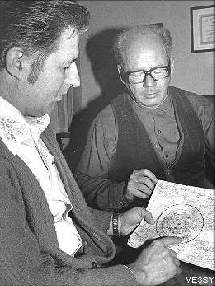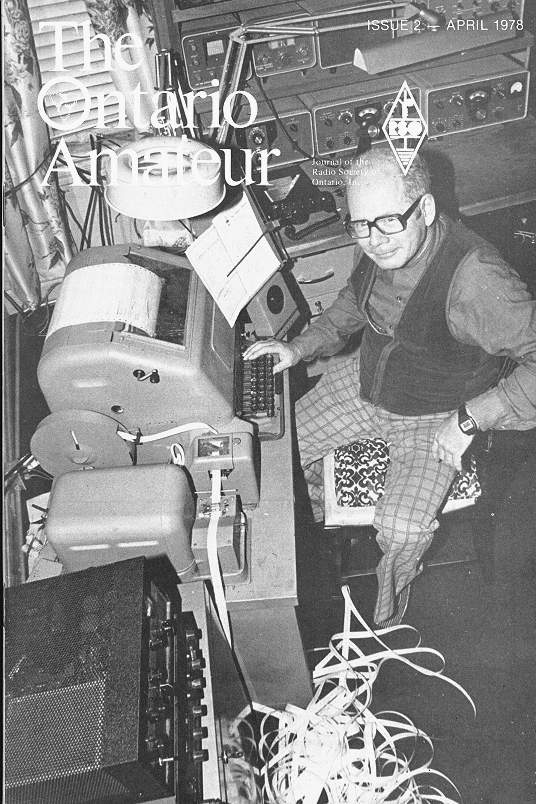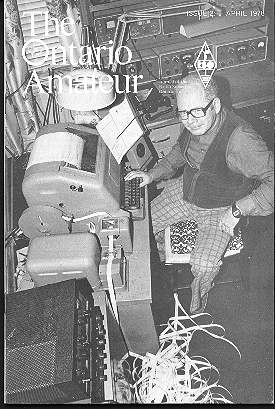
RSO
FM REPEATER
CODE PRACTICE
Text by:
Paul Cassel VE3AVY and
Harold Braun VE3DWH
Photos by: Paul Cassel VE3AVY (now VE3SY)
For many years the only source of code practice has been the nightly transmission from WLAW at ARRL Headquarters in Connecticut. As we all know, to receive these transmissions, a short wave receiver with a stable B.F.O. is required. Reception in our Province is limited to 80 and 40 metres and subjected to atmospheric noise and of course QRM.
Most budding amateurs who were interested in learning the code would invest in a SW receiver that would invariably be of little value once they obtained their license.
In September, 1975, John Riddell VE3AMZ, reported to the Kitchener-Waterloo Amateur Radio Club that the Kitchener-Stratford FM Association had voted in favor of transmitting nightly code practice on their repeater, VE3KSR. There was much discussion pro and con and the idea never received much response. Lloyd Ferns VE3BZF long an advocate of sending code practice in Ontario, felt practice sent on two metres would be of little value.
Fate works in many ways and slowly things began to fall into place. Lloyd VE3BZF purchased a Multi 2000 which included an audio oscillator to produce modulated CW in the FM mode. When Dick Smith, VE3EIE of Orangeville was leaving for the Maritimes he sold Lloyd his Model 19 Teletype machine.
At this point Lloyd remembered a QST article describing a simple way to produce perfect code using a teletype machine, a tape recorder and a polar relay. A subsequent search revealed all the details in QST for November, 1969.
Using the LETTERS "Z", "E" and "T" properly spaced code can be produced. Paper tapes can be produced, edited and reviewed before playing through a tape reader. Errors can simply be snipped out and replaced with correct information.
When played through the tape reader, the tape activates the polar relay which when connected to the Multi 2000 produces the CW signal.
 Lloyd Ferns VE3BZ and Harold Braun VE3DWH examine map showing sites of repeaters currently using 147.99OMHz Signal. Good signals are possible at repeater sites over 100 miles away. |
Several experimental transmissions were made and adjustments were necessary to change the audio frequency and eliminate bothersome key clicks.
After many conventional filters were tried, Lloyd threw away the books and tried some brute force filtering such as 5 Henries and 10 mfd. across the relay.
Success was finally achieved and on December 9, 1975 perfect code was transmitted via VE3KSR at Baden which has a normal coverage of 50 miles.
Practice was sent nightly, except Mondays which was club net night, at speeds of 5, 7 1/2, and 10 w.p.m. beginning at 7:00 P.M.
Prior to beginning transmissions, John VE3AMZ had a meeting with the local D.O.C. and had been successful in obtaining temporary permission to proceed with the idea.
Code practice ran nightly for the winter of 1975-76 over VE3KSR.
An experimental run was made through VE3TTY in Toronto with the approval of the licensee, Gord Clanfield VE3HKE.
The first night drew quick negative response from one user of VE3TTY wondering what CW was doing on a repeater. However, at a subsequent meeting the members of VE3TTY gave permanent approval for practice to be held during the winter of 1976-77.
This meant that Lloyd would have to transmit two complete sessions nightly, one at 7:00 P.M. in Toronto and one at 7:30 to VE3KSR at Baden. This code practice was done on 187 out of 188 scheduled nights on both repeaters. A Swan VHF linear amplifier was added to relieve the load on the Multi 2000 transceiver for the one hour plus transmissions.
In the spring of 1977 a commercial communications system company approached Lloyd requesting permission to erect a 200 foot tower and locate a commercial repeater on his farm. This user would employ a side mounted 45MHz antenna which would leave the top of the tower free for Lloyd's Two metre antenna. The commercial repeater would be housed in a building at the base of the tower.
A Sinclair Rapier collinear was installed atop the tower which peaked just over 1800 feet above sea level. This is just about level with the communications deck of the C.N. Tower.
Tests were made with fantastic results. Then lesson number one was learned. Never use a fiberglass antenna atop a 200 foot tower and expect it to survive lightning strikes. The tower took a direct hit totally demolishing the Rapier Antenna. The lightning entered the shack at the base of the tower housing the commercial repeater, blowing receptacles and fuse boxes off the wall. The "U" ground pin was completely melted off the plug of the repeater cord. The repeater, a GE Master 11 using a ferro-resonant transformer in the power supply, suffered no damage. After this strike and two subsequent strikes GE claim superb lightning immunity for this design of power supply. All strikes simply switch the repeater to battery power until AC is restored. No damage was ever done to the repeater itself.
After the Rapier antenna was blown apart, Lloyd met with Sinclair Radio Labs who suggested he use a SRL 224 antenna. This antenna is the four folded dipole type with each dipole at direct D.C. ground. It produces 6 D.B. gain over a dipole and can take direct lightning strikes. A special lightning rod was mounted to the very top of the 22 feet antenna and a licensed lightning rod installer ran approved heavy copper cable down through the tower, bonding everything together on its way to the base. Three additional ground rods were sunk and extra cable buried out to the guy anchors which were tied to ground systems.
A subsequent direct hit one peaceful afternoon lifted Lloyd and his visitor Hugh Cameron VE3EZR from their chairs. The resulting crash of thunder was so loud cattle ran out of their barns two miles away. All equipment survived at the tower part of the bolt came back along the hydro line damaging fuses and the TV in the house. Changes in the hydro system grounding are being made to correct this problem.
At the Ontario Hamfest and Flea Market held in July, 1977 at Milton, a meeting was held to hear recommendations regarding the idea of sending code out on one frequency for other repeater groups to receive and re transmit through their repeaters. Lloyd proposed to transmit on 147.99MHz with 100 watts E.R.P. Any group wishing to use the practice had only to install a 147.99 auxiliary receiver in their repeater.
This would allow as many repeaters as wished to repeat the practice and all at the same time.
R.S.O. and the D.O.C. gave their support and approval and Lloyd went on the air October 1, 1977, using the call VE3RSO.
The first night of practice had the following repeaters carrying the code: VE3WCR in Fonthill, VE3XPR in Brantford, VE3TTY in Toronto, VE3SSS/RRR Brampton (now VE3MHZ). These groups were joined on November 1, 1977 by VE3KSR at Baden when the final interface of the '99 receiver was made. VE3LSR in Orillia is now also carrying the practice every evening at 7:00 P.M.
During our interview with Lloyd, he expressed much concern that the original concept of code practice on 2 metres be maintained. It is not primarily for amateurs with 2 metre amateur receivers. It is for non-amateurs using, for the most part, inexpensive receivers containing the public service band. He urges everyone conducting classes to encourage their students to make full use of the sessions.
Because of this great work load, Lloyd would like to see a repeater established at his QTH with either a 45OMHz or a VHF input. This would allow others to access the 147.99 transmitter to provide the code practice from any point within range of his tower. All of the equipment presently being used for the code practice is owned by Lloyd. However the Kitchener-Stratford FM Association has donated a continuous duty 80 watt GE Transmitter to replace the Multi 2000 and Swan linear amplifier.
By todays standards this method of generating Morse code may seem outdated. However as indicated it has many advantages in simplicity, low cost and ease of supervision. If a repeater can be established then others could experiment with other modes of generation without upsetting the regular code practice sessions. In addition to code practice, Lloyd is also running the weekly R.S.O. bulletin in Morse code at 18 w. p.m. on Tuesday evenings. Should a repeater be installed at his QTH, it would be an excellent means of communicating to other groups during emergencies. Any groups or individuals interested in participating in these sessions or assisting Lloyd should contact him at R.R. #2, Orangeville, Ontario L9W 2Y9.

The above article was a reprint from the
April 1978 issue of The Ontario Amateur which at the time was the official monthly
publication of the Radio Society of Ontario. Due to lack of support, RSO surrendered its
Charter in the early 80's.
ed.
If you have any info please email us at webmaster@kwarc.org
© 1996 Kitchener-Waterloo Amateur Radio
Club
updated February 1, 97


